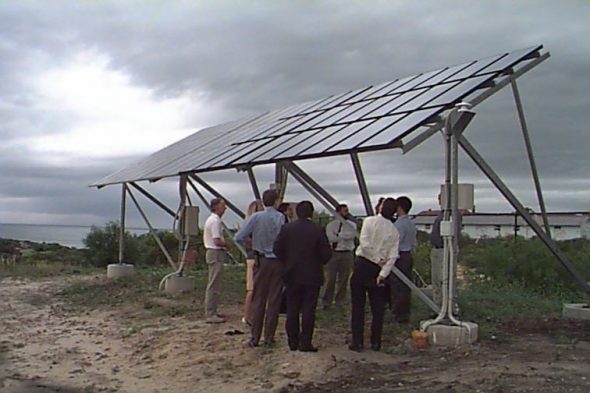At a recent 25-year reunion for the founders of the Australian solar industry, Muriel Watt recounted the experience of installing the first licenced solar PV generation facility in NSW. It was an eye-opener for the incumbent utilities, in more ways than one.
I had spent the 1980’s field testing Remote Area Power Systems (RAPS) and establishing a RAPS grant scheme for the Energy Authority of NSW, where I met many of the Solar Pioneers here today.
However, in 1992 I started work at the Uni of NSW and, with Ted Spooner, Hugh Outhred and Deo Prasad, plus David Roche, Michelle Guelden, Iain MacGill, Rob Largent, and others, we began the process of installing a 3kW PV array, plus (lead-acid) batteries, on a new, energy efficient building at the UNSW Little Bay campus.
A few issues arose immediately!
- Getting permission to connect to the Energy Australia grid
- Getting permission to be an electricity generator.
After many iterations, and close coordination with Energy Australia, (which initially expected our PV system to destroy their grid!) we developed a grid connect protocol for Little Bay. Nevertheless, as soon as we connected the inverter to the grid, we experienced trips.
Energy Australia blamed the inverter, so Ted Spooner monitored the grid voltage for some time and was able to show that it fluctuated wildly – certainly out of the approved range!
That was an eye opener for Energy Australia, which proceeded to tap the local substation transformer down a notch.
 This experience was repeated across the country as the accurate electronic inverter settings came up against the much less accurate electro-mechanical grid controls.
This experience was repeated across the country as the accurate electronic inverter settings came up against the much less accurate electro-mechanical grid controls.
It even extended to frequency trips on the Alice Springs grid once PV installations began to increase and the very tight specifications the utilities had insisted be applied to inverters came back to bite them.
Generator approval was another saga! The only option was to fill in a form designed for a 660MW coal fired power station! We duly did this and began the process of suggesting it was a slight overkill and that a simplified process could be implemented for small PV systems.
We were successful in getting an exemption for small PV generators (<30kW). Little Bay was the first licensed PV power generation facility in NSW connected to the grid, and was opened by the Minister for Energy on 17 Oct 1994.
In 1996 with input from the ESAA and a committee comprised of utility and industry people, Ted Spooner drafted Grid Connect Guidelines for PV and they were made available to the industry in 1998.
This was a world first and, along with the generator exemptions and customer agreement templates developed with the utilities, allowed rapid uptake of PV once incentives were offered – compare this to the continued problems, high costs and long delays still faced by US customers when applying for grid connection of their PV.
The first grid connect standard AS4777 parts 1-3 was published in 2002 and has become a benchmark for the region and the world.
In 1996, SEDA installed a 7.2kW array – for $65,000 ($9/W) and offered a 20% grant for PV on buildings – the beginning of our wonderful grid connected PV journey!
Little Bay became the first test centre for grid connected inverters and was instrumental in approving all Australian inverters for grid connection for many years until ACRELab came on line.
Many inverter manufacturers who thought they met the guidelines found bugs in their software due to our testing and one US manufacturer managed to island for long periods. We worked with the manufacturers to improve their algorithms and this resulted in many passing and receiving approvals.
Olympic Village, which came onstream in 2000, was also an important development as it was a multi-inverter installation that came with some new and interesting issues and worries for utilities, like islanding. The successful installation led to an increased confidence that these systems would not “break the grid”.
Muriel Watt in an advisor with ITP Renewables (and previously UNSW).
Muriel’s note: This is an excerpt from a more rambling reminisce at the recent Solar Pioneers get-together in Sydney. It may differ from other people’s memories of course!












